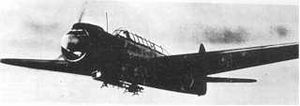Nakajima B6N
| B6N | |
|---|---|
 |
|
| B6N2 in flight | |
| Role | Torpedo bomber |
| National origin | Japan |
| Manufacturer | Nakajima Aircraft Company |
| First flight | 14 March 1941 |
| Introduction | August 1943 |
| Retired | 1945 |
| Primary user | Imperial Japanese Navy |
| Number built | 1,268 |
The Nakajima B6N Tenzan (Japanese: 中島 B6N 天山—"Heavenly Mountain", Allied reporting name: "Jill") was the Imperial Japanese Navy's standard carrier-borne torpedo bomber during the final years of World War II and the successor to the B5N "Kate". Due to its protracted development, a shortage of experienced pilots and the United States Navy's achievement of air superiority by the time of its introduction, the B6N was never able to fully demonstrate its combat potential.
The B5N carrier torpedo-bomber's weaknesses had shown themselves early in the Second Sino-Japanese War and, as well as updating that aircraft, the Imperial Japanese Navy began seeking a faster longer-ranged replacement. In December 1939 it issued a specification to Nakajima for a Navy Experimental 14-Shi Carrier Attack Aircraft capable of carrying the same external weapons load as the B5N. The new plane was to carry a crew of three (pilot, navigator/bombardier and radio operator/gunner) and be of low wing, cantilevered, all-metal construction (though control surfaces were fabric-covered). Further requirements included a top speed of 250 knots (460 km/h; 290 mph), a cruising speed of 200 knots (370 km/h; 230 mph) and a range of 1,000 nmi (1,900 km; 1,200 mi) with an 800 kg (1,800 lb) bomb load or 2,072 nmi (3,837 km; 2,384 mi) without external armament.
The Navy had requested installation of the proven Mitsubishi Kasei engine as the B6N's powerplant but Engineer Kenichi Matsumara insisted on using Nakajima's new 1,870 hp (1,390 kW) Mamori 11 14-cylinder air-cooled radial due to its lower fuel consumption and greater adaptability. This became an unfortunate choice as the Mamori engine was plagued with mechanical defects and never achieved its expected power rating.
Constrained by the standard-sized aircraft elevators then in use on most Japanese carriers, designer Matsumara was obliged to use a wing similar in span and area as that of the B5N and to limit the aircraft's overall length to 11 m (36 ft). This latter restriction accounted for the B6N's distinctive swept-forward tail fin and rudder.[1] The outer wing panels folded upward hydraulically, reducing the B6N's overall span from 14.9 m (49 ft) to approximately 6.3 m (21 ft) for minimal carrier stowage. In order to lessen increased wingloading due to the heavier powerplant, Fowler flaps were installed which could be extended beyond the wing's trailing edge. These were normally lowered to an angle of 20 degrees during take-off and 38 degrees when landing. Despite the use of these flaps, however, the B6N had a much higher stall speed than its predecessor.
...
Wikipedia
